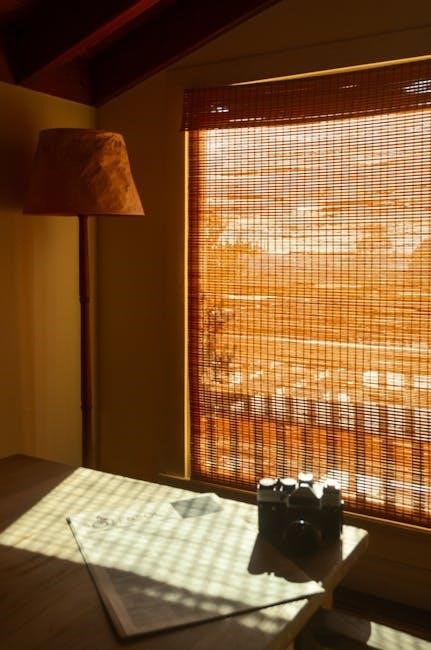Proper table lamp shade sizing balances aesthetics and functionality, ensuring optimal light distribution and visual harmony. Measure lamp height and base to determine the ideal shade proportions for a polished look.
Why Proper Shade Size Matters
Proper shade sizing is crucial for both functionality and aesthetics. A well-sized shade ensures even light distribution, preventing harsh glare or insufficient illumination. It also maintains the lamp’s visual balance, avoiding a disproportionate appearance that can disrupt room decor. Additionally, the right shade size enhances energy efficiency by directing light appropriately. Oversized shades may block too much light, while undersized ones can create unflattering shadows. Proper sizing also reflects personal style, complementing the room’s ambiance and serving its intended purpose, whether for task or ambient lighting. Ultimately, correct shade sizing elevates both form and function, making it a key element in interior design.
Key Considerations for Choosing the Right Shade
When selecting a table lamp shade, consider the lamp’s height, base size, and intended use. Measure the lamp from base to bulb to determine shade height, typically 60-80% of the lamp’s total height. The shade’s diameter should proportionally match the base, ensuring stability and balance. Room style, lighting purpose, and personal aesthetics also play a role. For task lighting, choose a shade that directs light downward, while ambient lighting may require a more diffused design. Material and color should align with interior decor, and energy efficiency can be enhanced with light-directing liners. Testing different shades can help finalize the perfect choice for functionality and style.
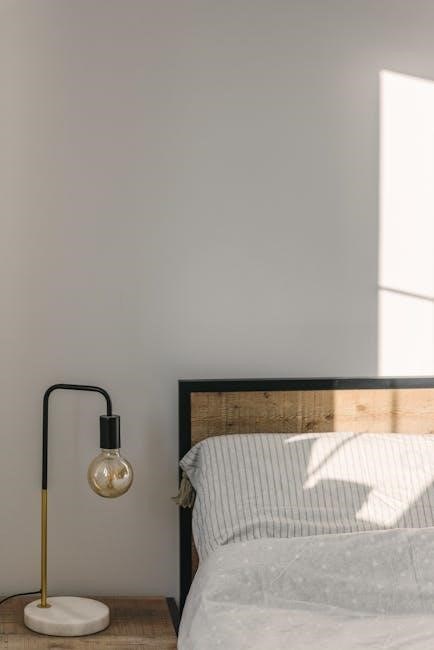
Understanding Lamp Anatomy
A table lamp consists of a base, harp, socket, and bulb, with the shade attached to the harp. These components influence shade size and light direction, affecting room aesthetics and functionality.
Components of a Table Lamp
A table lamp typically includes a base, harp, socket, bulb, and shade. The base provides stability, while the harp holds the shade in place; The socket houses the bulb, and the switch controls the light. These elements work together to create balanced lighting. When selecting a shade, consider the size and proportions of the base and harp to ensure compatibility. The height of the lamp from base to socket also influences the ideal shade dimensions. Proper alignment of these components ensures both functionality and aesthetic appeal, making the lamp a cohesive addition to any room.
The Role of the Shade in Lighting
The shade plays a crucial role in lighting by controlling light direction and intensity. It diffuses or directs light, reducing glare and creating a comfortable environment. A well-sized shade ensures optimal light distribution, enhancing both task and ambient lighting needs. Proper sizing also prevents harsh shadows, contributing to a balanced room ambiance. The shade’s material and color further influence light output, with lighter materials allowing more diffusion and darker ones focusing light more narrowly. Ultimately, the shade’s design and proportions are essential for achieving the desired lighting effect, making it a key element in lamp functionality and interior design.
Measuring Your Table Lamp
Measure the lamp’s height from base to bulb and the base’s width. These dimensions guide shade size selection, ensuring proportionate and functional lighting.
How to Measure the Lamp Base
To measure the lamp base, start by determining its width. Use a ruler or tape measure across the widest part of the base. Record this measurement accurately. Next, assess the height of the lamp from the base to the top, including the bulb and harp. This height helps calculate the appropriate shade proportions. Ensure measurements are precise to maintain balance and aesthetics. Proper sizing enhances both functionality and visual appeal, making the lamp a cohesive element in any room. Always consider these measurements when selecting a shade for optimal results.
Calculating the Ideal Shade Height
To determine the ideal shade height, measure the lamp’s total height from the base to the top of the bulb or harp. For table lamps, the shade height should be 60-70% of the lamp’s total height. For example, a 24-inch lamp would need an 8-10 inch shade. This proportion ensures the shade is neither too tall nor too short, maintaining visual balance. The height should also align with the lamp’s purpose, such as task lighting requiring a lower shade for focused light. Always consider the room’s style and lighting needs when finalizing the shade height for the best aesthetic and functional results.
Determining the Appropriate Shade Diameter
The shade diameter should complement the lamp base and fit the room’s decor. Measure the base’s width at its widest point. For table lamps, the shade diameter typically ranges from 1.5 to 2 times the base’s width. For instance, a 6-inch base would pair well with a 9-12 inch diameter shade. Ensure the shade is wide enough to cover the light source but not so wide that it overwhelms the space. The diameter also affects light distribution, with wider shades providing ambient light and narrower ones offering focused illumination. Consider the lamp’s placement, such as on a bedside table or desk, to choose a diameter that enhances functionality and style.
Proportional Guidelines for Shade Sizing
Shade sizing should maintain harmony with the lamp base and room aesthetics. Standard ratios ensure balance, while height-to-width proportions create visual equilibrium, enhancing overall design cohesion naturally.
Standard Shade-to-Lamp Base Ratios
Standard shade-to-base ratios ensure a balanced look. For table lamps, the shade height typically ranges between 60% to 80% of the lamp’s total height. The diameter should be roughly proportional to the base width, often around 1-1.5 times the base’s width for a harmonious appearance. These ratios help maintain visual equilibrium, preventing the shade from appearing too large or small. Proper alignment enhances both functionality and aesthetics, ensuring the lamp complements the room’s decor while providing adequate lighting. Adhering to these guidelines ensures a polished, professional look in any setting.
Height-to-Width Proportions for Balance
The height-to-width proportions of a lamp shade are crucial for achieving balance. Ideally, the shade height should be 60-80% of the lamp’s total height, while the width should complement the base. A general rule is that the shade’s diameter should be 1-1.5 times the width of the lamp base. This ensures the shade neither overwhelms nor appears too small. Proper proportions create visual harmony and prevent the lamp from looking top-heavy or unstable. Balancing these dimensions ensures the lamp is both functional and aesthetically pleasing, contributing to a cohesive room design. Always consider the lamp’s placement and surrounding decor when selecting proportions.
Adjusting for Different Lamp Styles
Different lamp styles require tailored shade sizing to maintain aesthetic consistency. For modern lamps, slimmer shades with proportional heights work best, while traditional lamps often pair well with slightly larger, more ornate shades. Industrial-style lamps may benefit from exposed bulbs or minimalist shades, emphasizing functionality. When adjusting for style, consider the lamp’s design elements, such as curves or straight lines, to ensure the shade complements its form. Measure the lamp’s height and base to determine the appropriate shade proportions, then select a style that aligns with the room’s decor. This ensures the lamp remains a cohesive element in the space, blending form and function seamlessly.

Factors Influencing Shade Size
Room style, lighting purpose, and personal aesthetics significantly influence shade size. Task lighting may require smaller, focused shades, while ambient lighting benefits from larger, softer shades to illuminate spaces evenly.
Room Style and Interior Design
Room style and interior design play a crucial role in determining the appropriate shade size for table lamps. Modern spaces often favor sleek, minimalist shades, while traditional settings may lean toward ornate or larger designs. The scale of furniture and decor within the room also influences shade proportions. For instance, a lamp in a minimalist room should have a shade that complements the simplicity of the space, ensuring visual harmony. Conversely, a room with bold patterns and textures can accommodate more substantial or decorative shades. Additionally, the color and material of the shade should align with the room’s aesthetic to maintain a cohesive look. Properly sized shades enhance both functionality and the overall design of the room, creating a balanced and inviting atmosphere.
Lighting Purpose (Task vs. Ambient)
The purpose of the lighting—whether task-oriented or ambient—affects the ideal shade size. Task lighting, such as reading, requires focused light, often benefitting from a narrower shade to direct light downward. In contrast, ambient lighting aims to create a soft, diffused glow, which can be achieved with a wider shade. The shade’s size and shape influence light distribution; smaller shades provide concentrated illumination, while larger ones spread light more broadly. When selecting a shade, consider its functionality: task lamps need precise light control, whereas ambient lamps prioritize even light dispersion. This ensures the lamp meets its intended purpose while maintaining visual appeal.
Personal Aesthetic Preferences
Personal aesthetic preferences play a significant role in choosing the right table lamp shade size. The shade’s style, color, and design should align with the room’s decor and individual taste. For instance, modern spaces might favor sleek, minimalist shades, while traditional settings could benefit from more ornate patterns. The shade’s proportions should complement the lamp base and surrounding furniture, creating a cohesive look. Consider the room’s color palette when selecting a shade to ensure harmony. Additionally, the shade’s material and texture can enhance the overall aesthetic, adding depth and visual interest. Balancing functionality with personal style ensures the lamp becomes a decorative focal point, reflecting one’s unique taste while providing effective lighting. This blend of practicality and creativity allows the lamp to enhance both the functionality and beauty of the space.
Practical Tips for Choosing the Right Shade
Using a measuring guide simplifies shade selection. Test different shades to ensure fit and style; Consider light direction and output for optimal functionality and ambiance.
Using a Measuring Guide
A measuring guide is essential for selecting the right shade size. Start by measuring the lamp’s total height and base width. Use these dimensions to determine the ideal shade proportions. Generally, the shade height should be 60-80% of the lamp’s total height, while the diameter should be 1.5 to 2 times the base width. Record these measurements and compare them with standard sizing charts. This ensures a balanced and functional design. Always use a ruler or tape measure for accuracy. Testing the fit of the shade on the lamp is also recommended to confirm proportions. This method guarantees both style and practicality, making the process straightforward and effective.
Testing Different Shades
Testing different shades is a practical way to ensure the perfect fit for your table lamp. Start by trying shades of varying sizes, styles, and materials to see how they complement the lamp base and surrounding decor. Pay attention to how the shade affects light output and ambiance; Consider the room’s lighting needs—task lighting requires focused illumination, while ambient lighting benefits from softer diffusion. Experiment with shapes, such as drum or bell shades, to find the most flattering option. Finally, observe how the shade interacts with the room’s aesthetics and functionality, ensuring it enhances both without overpowering the space. This hands-on approach guarantees satisfaction and harmony in your lighting choice.
Considering Light Direction and Output
When selecting a lamp shade, consider the direction and intensity of light it produces. A shade’s material and opacity significantly impact light output—translucent shades diffuse light softly, while opaque ones direct it downward. For task lighting, choose a shade that focuses light, such as a narrower or cone-shaped design. Ambient lighting benefits from wider, softer shades that scatter light. Additionally, the shade’s color affects brightness; white or light-colored shades reflect more light, while darker shades create a warmer, cozier glow. Balancing these factors ensures the lamp meets your lighting needs, enhancing functionality and atmosphere in any room. Proper alignment of shade features with intended use is key to achieving desired results.
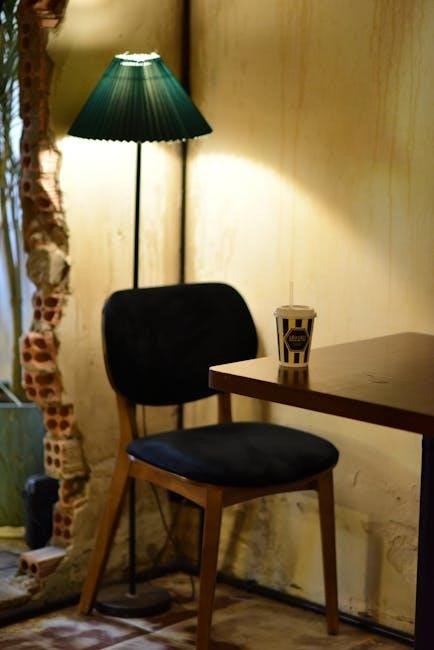
Common Mistakes to Avoid
Common mistakes include oversized shades overwhelming lamps, undersized shades appearing out of proportion, and ignoring lamp proportions, which disrupts balance and functionality.
Oversized Shades
Oversized shades are a common mistake that can disrupt the balance of a table lamp and the room. A shade that is too large can overwhelm the lamp base, creating an unbalanced look. It may also obscure light unnecessarily, reducing functionality. Proper proportions are key, as the shade should complement the lamp’s height and width without dominating it. For example, a shade that is too tall or wide can make the lamp appear bulky or overly decorative. To avoid this, measure the lamp’s height and base to ensure the shade aligns with recommended proportional guidelines. Oversized shades can distract from the room’s design and hinder the lamp’s intended purpose, whether it’s task or ambient lighting. Always aim for harmony between the shade and the lamp’s structure to maintain a cohesive aesthetic.
Undersized Shades
Undersized shades are another common pitfall in table lamp design. A shade that is too small may fail to adequately cover the light source, leading to excessive glare. This can make the lamp less functional and visually unappealing. Additionally, an undersized shade can throw off the balance of the lamp’s proportions, making it appear unstable or poorly designed. Proper sizing ensures the shade effectively diffuses light while maintaining aesthetic harmony. Always refer to size guidelines to avoid this mistake, as it can significantly impact both the functionality and visual appeal of the lamp. A well-sized shade ensures optimal lighting and enhances the overall decor of the room.
Ignoring Proportions
Ignoring proportions when selecting a lamp shade can disrupt the balance and harmony of the lamp’s design. A shade that is too large or too small relative to the lamp base can create an unbalanced look, making the lamp appear awkward or poorly designed. Proper proportions ensure the shade complements the lamp’s structure, providing both functional and aesthetic benefits. For example, a shade that is too small may not adequately diffuse the light, while an overly large shade can overwhelm the space. Always consider the lamp’s height, base size, and intended use when choosing a shade to maintain visual harmony and functionality. This ensures the lamp enhances the room’s decor effectively.
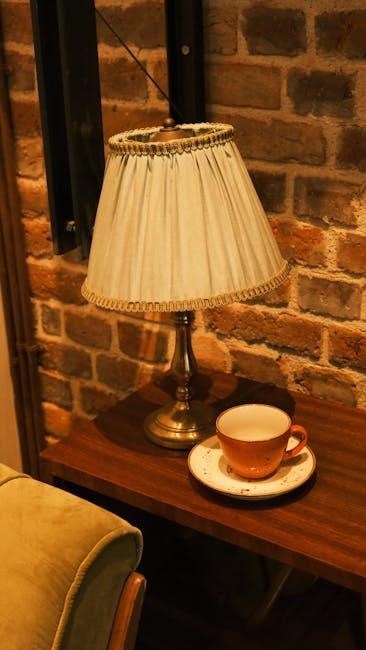
Advanced Shade Sizing Techniques
Refine proportions by considering room decor, light direction, and lamp style. Advanced techniques involve balancing scale, texture, and color to create a cohesive, polished lighting design.
Visual Balance in the Room
Achieving visual balance requires coordinating lamp shade size with room proportions. Ensure the shade complements furniture and decor by maintaining proportional harmony, creating a cohesive, inviting space. Proper sizing enhances both functionality and aesthetics, ensuring the lamp doesn’t overwhelm or underwhelm the setting. Consider the lamp’s placement and surrounding elements to strike equilibrium, making the room feel balanced and stylish. This approach ensures the lamp seamlessly integrates into the overall design, contributing to a harmonious environment. Always measure and compare to guarantee the shade aligns with the room’s aesthetic and functional needs.Balance is key to a polished, attractive interior.
Matching Shade Size to Table Size
Pairing the shade size with the table dimensions ensures a cohesive look. For smaller tables, opt for a compact shade, while larger tables accommodate bigger shades. Measure the table’s width and height to align the shade proportions, preventing the lamp from appearing out of scale. Harmonizing the shade with the table’s size enhances the room’s balance. Consider the lamp’s height relative to the table’s surface for practical lighting. Proper sizing ensures the lamp complements the table without overwhelming it. Always assess the table’s dimensions to select a shade that fits seamlessly, creating a balanced and visually appealing setup. This ensures functionality and style are maintained.
Harmonizing with Other Lighting Elements
Coordinating the table lamp shade with other lighting fixtures ensures a unified design. Consider ceiling lights, floor lamps, and wall sconces when selecting the shade. Match the shade’s style and finish to existing elements for consistency. Ensure the lamp’s height and shade size complement surrounding decor. The shade’s material and color should align with the room’s aesthetic, creating visual harmony. Proper alignment enhances the overall lighting scheme, providing both functional and ambient illumination. By harmonizing the shade with other lighting, the space achieves a balanced and polished appearance, contributing to a cohesive interior design. This integration is key to a well-designed room. Always consider the broader lighting context for optimal results.
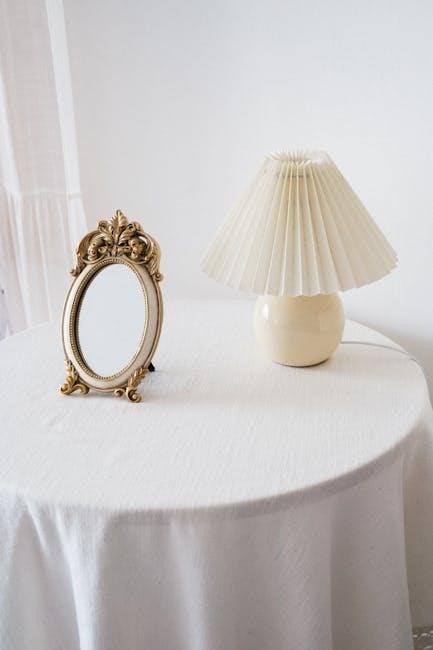
Specialized Shade Size Scenarios
Different settings require tailored shade sizes. Bedside lamps need compact shades, while living room lamps may use larger ones for ambient lighting. Desk lamps prioritize task-oriented sizing, ensuring focused light without glare. Each scenario demands specific proportions to maximize functionality and style, adapting to the room’s purpose and design. Proper sizing enhances utility and aesthetics, making each lamp suit its intended space perfectly. Always consider the room’s function when choosing shade sizes.
Bedside Table Lamps
Bedside table lamps require shades that provide soft, focused lighting for reading and relaxation. The shade height should be 60-80% of the lamp’s total height, ensuring the light is directed downward without glare. For a lamp that’s 24 inches tall, the shade should be around 8 inches tall. The diameter should complement the base, typically 1-2 inches wider than the base’s width. Soft, rounded shades in neutral tones are ideal for creating a calming atmosphere. Avoid oversized shades that may overwhelm the space. Proper sizing ensures functionality and maintains a serene bedroom ambiance, making it easier to unwind and sleep comfortably. Additionally, consider the room’s style and your personal preferences when selecting the shade design and material. This balance ensures both practicality and aesthetic appeal in the bedroom setting.
Living Room Table Lamps
Living room table lamps should harmonize with the space while providing ambient or task lighting. The shade size should complement the lamp’s height and base, with a diameter roughly 1-2 inches wider than the base. For a 24-inch lamp, a shade height of 8-10 inches works well. Soft, rounded shades in neutral tones enhance coziness, while bolder designs can add a decorative touch. Ensure the shade directs light downward for task lighting or upward for ambient illumination. Proportional sizing ensures the lamp blends seamlessly with the room’s decor, contributing to a balanced and inviting atmosphere. Consider the room’s style and lighting needs when selecting the shade. Proper sizing enhances functionality while maintaining aesthetic appeal. Tailor the shade to reflect your personal style for a cohesive look. Always measure carefully to achieve the perfect fit for your living room setup. The right shade size can elevate the entire room’s ambiance, making it a key element in interior design. By balancing form and function, you create a space that is both beautiful and practical. This ensures your living room remains a comfortable and stylish hub for relaxation and entertaining. Choosing the ideal shade size is a simple yet impactful way to enhance your home’s decor. It allows you to enjoy optimal lighting while maintaining a visually appealing environment. The shade’s proportions play a crucial role in achieving this balance, making it essential to select the right size for your living room table lamp. With careful consideration, you can create a warm and welcoming space that reflects your personal taste.
Desk and Task Lamps
Desk and task lamps require precise shade sizing for focused lighting. The shade should be slightly narrower than the lamp base, with a height of 6-8 inches for most setups. Ensure the shade directs light downward to minimize glare. The diameter should match the base width, creating a balanced look. Neutral tones like white or gray are ideal for task-oriented environments. Proper sizing ensures the lamp provides effective illumination without overwhelming the workspace. Measure the lamp’s base and choose a shade that complements its proportions. This ensures optimal light distribution and a professional appearance. The right shade size enhances productivity while maintaining a sleek, functional design. Always prioritize functionality while selecting a shade that fits your workspace decor. The shade’s size and shape should align with the lamp’s purpose, ensuring it meets your specific lighting needs. By selecting the correct proportions, you can create a focused and efficient workspace. The shade’s dimensions play a crucial role in achieving this balance, making it essential to choose wisely. With careful consideration, you can enjoy a well-lit and organized workspace that supports productivity and comfort. Proper sizing ensures the lamp performs its intended function effectively, making it a valuable addition to your desk setup. The shade’s size directly impacts the lamp’s ability to provide task lighting, so it’s important to get it right. This ensures you can work efficiently without unnecessary distractions. The right shade size will enhance your overall experience, making it a worthwhile investment for your workspace. By following these guidelines, you can select a shade that meets both practical and aesthetic requirements. This approach ensures your desk lamp is both functional and visually appealing, contributing to a productive and comfortable working environment.
Proper table lamp shade sizing is crucial for both functionality and aesthetics. By measuring and proportioning correctly, you ensure optimal light distribution and a visually appealing design. Experiment to find the perfect fit for your space and lighting needs.
Final Thoughts on Shade Sizing
Choosing the right table lamp shade size is a balance of form and function. Proper sizing enhances lighting efficiency and aesthetic appeal, ensuring your lamp complements the room’s decor. Measure carefully, considering the lamp’s height, base, and intended use. While guidelines provide a foundation, personal style and space requirements should influence your final decision. Experiment with different shades to find the perfect fit, as the right size can transform a room’s ambiance. Remember, the goal is to create harmony between the lamp and its surroundings, ensuring both practical lighting and visual appeal.
Encouragement to Experiment
Don’t hesitate to explore different shade sizes and styles to find the perfect fit for your table lamp. Experimentation allows you to discover unique combinations that reflect your personal taste and enhance your space. While guidelines offer a starting point, they shouldn’t limit your creativity. Try varying proportions, shapes, and materials to see what works best in your setting. Remember, the right shade can elevate the entire room’s aesthetic. Take your time and enjoy the process of transforming your lamp into a stunning centerpiece that blends functionality with style, creating a harmonious and inviting atmosphere.
